For the past five years, the Neurosurgery Careers Day hosted by the Neurology and Neurosurgery Interest Group (NANSIG) and the Society of British Neurological Surgeons (SBNS) has inspired and guided the enthusiastic minds of medical students considering a career in neurosurgery. This year was no different, and on 21 January 2017, the sixth annual SBNS/NANSIG Neurosurgery Careers Day held at The Royal College of Surgeons (RCS) yet again shed light on the path towards becoming a neurosurgeon – and what lies beyond.
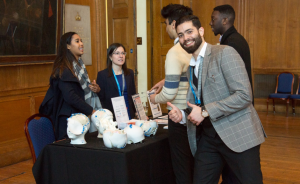 The close-knit collaboration of the neurosurgeons and SBNS committee with the medical students and junior doctors who make up NANSIG demonstrated the unity and cohesive bond that people in this field share. This unity helped relax the potentially daunting nature of a careers talk about neurosurgery, creating a truly pleasant atmosphere for discussions with surgeons at different stages of their training.
The close-knit collaboration of the neurosurgeons and SBNS committee with the medical students and junior doctors who make up NANSIG demonstrated the unity and cohesive bond that people in this field share. This unity helped relax the potentially daunting nature of a careers talk about neurosurgery, creating a truly pleasant atmosphere for discussions with surgeons at different stages of their training.
Our train of thought was set in motion by Mr Alistair Jenkins, SBNS Treasurer and Consultant Neurosurgeon at The Royal Victoria Infirmary, Newcastle, who spoke to us about what made him choose his career. The insight Mr Jenkins offered into his personal life drew an important parallel between his individual development and consequent progression through his professional career. It was also rather amusing (and impressive) to see the variety of ‘looks’ Mr Jenkins has sported in the different eras he has lived through. His talk drove home the message that being a neurosurgeon is indeed a calling, where it is almost essential to enjoy neurosurgery to the extent where only a thin boundary separates work and play. Getting us to consider what classifies a job as ‘work’ was a helpful step towards realising whether we have the temperament needed to succeed as a neurosurgeon.
Mr Jonathan Pesic-Smith, a neurosurgical ST6 currently training at The Royal Victoria Infirmary, Newcastle, then spoke to us about what the life of a trainee entails. He advised us to look at the worst bits of a job before selecting it as this offers a fundamentally practical basis for deciding whether neurosurgery is the right choice for you. Aware of the glamour associated with ‘brain surgery’, Mr Pesic-Smith made sure that prospective applicants at the careers day were well aware of the reality, hence preparing us for the stress, exhaustion, and ‘out of your depth’ feeling that a trainee must learn to endure.
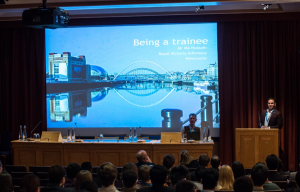
This led us on to our next speaker, Mr Akbar Hussain, a neurosurgical registrar at the Royal Victoria Infirmary, Newcastle, on course for starting his fellowship programme. Mr Hussain told us ‘Being a good neurosurgeon is not about ticking boxes’, a message that added to a running theme of discussion which drew thoughts on the intensive and rather gruelling nature of the modern-day selection process. Hearing from someone who has thrived through this process was very inspiring. Mr Hussain helped us understand that given the hurdles that exist at each step towards becoming a neurosurgeon, one must realise that mentally preparing yourself to excel in an alternative field can be as important as a complete dedication to attaining a career in neurosurgery.
In his talk about balancing work and personal life, Mr Richard Nelson, Consultant Neurosurgeon at Southmead Hospital, Bristol, declared: ‘There is no such thing as work-life balance. Everything worth fighting for unbalances your life.’ The admiration and respect with which Mr Nelson spoke about his surgical team revealed how colleagues eventually become members of a second family for a neurosurgeon. The humble aura of a man with decades of experience behind him truly set a great example for all junior doctors and students to follow. The key messages from Mr Nelson’s talk were the importance behind strengthening our bond with family and friends, the need to get out there and enjoy nature when you can, and also making sure to act silly every now and then (within reason!).
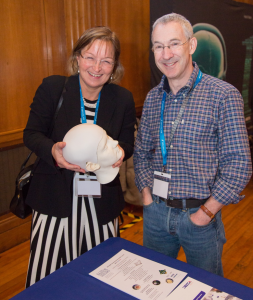 In a hall full of aspiring neurosurgeons, there was a buzzing anticipation to play around with surgical equipment and get a feel for the current technology in use. Fortunately, there was plenty of time to do just that with several different pieces of equipment laid out for us to get our hands on. Mr Richard Ashpole gave us an intriguing introduction to ROWENA, a model he developed to produce an extremely accurate simulation of what operating is like. The way he has developed this enterprising company from a hobby that began on his kitchen table demonstrates the different possibilities of a career in neurosurgery, be it entrepreneurship, technology development, or research. We were then given a three-dimensional look into the brain by M Thomas Santarius, Consultant Neurosurgeon at Addenbrooke’s Hospital, Cambridge, who guided us through several different surgical procedures. This was a remarkable experience, revealing the intricacies involved in each of these operations.
In a hall full of aspiring neurosurgeons, there was a buzzing anticipation to play around with surgical equipment and get a feel for the current technology in use. Fortunately, there was plenty of time to do just that with several different pieces of equipment laid out for us to get our hands on. Mr Richard Ashpole gave us an intriguing introduction to ROWENA, a model he developed to produce an extremely accurate simulation of what operating is like. The way he has developed this enterprising company from a hobby that began on his kitchen table demonstrates the different possibilities of a career in neurosurgery, be it entrepreneurship, technology development, or research. We were then given a three-dimensional look into the brain by M Thomas Santarius, Consultant Neurosurgeon at Addenbrooke’s Hospital, Cambridge, who guided us through several different surgical procedures. This was a remarkable experience, revealing the intricacies involved in each of these operations.
Ms Anne Moore, the Senior Vice President of RCS, delivered a particularly inspiring talk about being a woman in neurosurgery. The relevance of this topic today is evident in the fact that only about 11% of consultant surgeons in England are women. As Ms Moore spoke, she stood in front of the women and men in the audience as the epitome of persistence and self-belief, proving to us that anything you set your mind to is indeed possible. She also discussed ways to balance the responsibilities of working as a neurosurgeon and starting a family.
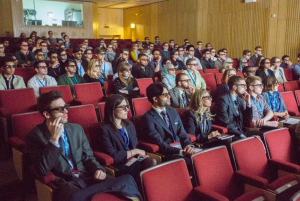 The Braun Prize was awarded to three research projects which were presented at the conference by medical students and junior doctors. The presentations were focused on the effects of deep brain stimulation of the sub-thalamic nucleus on rigidity in Parkinson’s, the relationship of trajectory with target engagement and on the timing of emergency referrals to neurosurgery. All three topics were well-researched, providing results in a concise manner and indicating future possibilities of further exploration in the field. There were also several posters displayed that demonstrated the keen interest of medical students in neurosciences and neurosurgery.
The Braun Prize was awarded to three research projects which were presented at the conference by medical students and junior doctors. The presentations were focused on the effects of deep brain stimulation of the sub-thalamic nucleus on rigidity in Parkinson’s, the relationship of trajectory with target engagement and on the timing of emergency referrals to neurosurgery. All three topics were well-researched, providing results in a concise manner and indicating future possibilities of further exploration in the field. There were also several posters displayed that demonstrated the keen interest of medical students in neurosciences and neurosurgery.
To round off the day, Mr Paul May, President of the SBNS, spoke to us about ‘our’ neurosurgical family, concluding the event on an uplifting note, evoking the desire of potential neurosurgeons in the audience to find their way into this family. The excitement and motivation with which delegates left the conference hall was evident. The SBNS/NANSIG careers day achieved its purpose of showing us the many facets of a career in neurosurgery: the hurdles, the passion, the knowledge, and the life-long learning and dedication that lies ahead.
All photos used in this post credited to John Murray – PNJ photography www.pnjphotography.com. To view all of John’s photos from the event click here.
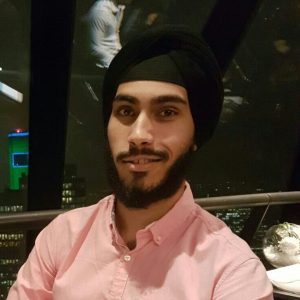 Prabhjot Malhotra is a third year international medical student at HYMS. He has a keen interest in neurology and neurosurgery, and is hoping to pursue an MSc in Clinical Neurosciences. In his spare time, he enjoys competing in chess and poker tournaments, playing the violin and travelling around the world to explore different walks of life.
Prabhjot Malhotra is a third year international medical student at HYMS. He has a keen interest in neurology and neurosurgery, and is hoping to pursue an MSc in Clinical Neurosciences. In his spare time, he enjoys competing in chess and poker tournaments, playing the violin and travelling around the world to explore different walks of life.

